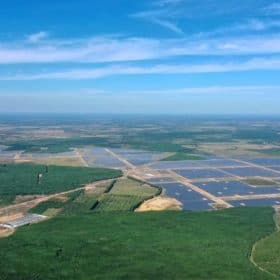Southeast Asia solar markets set for growth this year
New PV capacity additions in Southeast Asia are expected to bounce back this year for the first time since 2020, according to the Asian Photovoltaic Industry Association. The market is expected to grow by 13% in 2023, for 3.8 GW of new installations.
Indonesia’s race to net zero
Coal-dependent Indonesia has huge solar potential but progress toward a net zero economy has been sluggish, explain Daniel Kurniawan and Fabby Tumiwa from the Institute for Essential Services Reform (IESR), an Indonesian thinktank.
Indonesia’s largest floating solar plant goes online
Indonesia’s PT PLN says it has started operating a 561 kW floating solar plant on the island of Java. The floating array, which is part of a larger 920 kW PV project under construction at the company’s Gas and Steam Power Generation Complex, is expected to generate 1.4 million kWh a year.
Key takeaways from Solartech Indonesia 2023
The Jakarta-hosted Solartech tradeshow showed the Indonesian renewable energy landscape’s potential, despite the small size of its solar market.
Indonesian utility PLN seeks equity partners for large scale PV, wind projects
Indonesian state-owned utility PLN is seeking expressions of interest for several ground-mounted, floating solar projects and wind farms. The call includes an invitation to set up solar module factories in Indonesia to meet domestic content requirements.
Weekend Read: Floating the solar dream
Indonesia is a coal-dependent country in which conventional power grids are problematic. The archipelagic nation is turning to floating PV (FPV) to help accelerate its energy transition. Sorta Caroline takes a look at the state of play for water-borne solar and the problems that still need to be overcome.
Indonesian utility kicks off tender for 100 MW floating solar plant
PT PLN Nusantara Power has launched a tender for a floating PV project that will likely be built at a dam on the island of Java, Indonesia.
Cooling solar modules with vacuum pressure
Scientists in Indonesia have developed a vacuum technique to lower the temperature of PV modules below the ambient air temperature. They applied it to a solar module in a casing that is resistant to negative pressure.
EDPR Sunseap testing solar floaters made of recycled plastic
PlasticBean, a manufacturer of recycled plastic pellets, has agreed to work with EDPR Sunseap to use 100% recycled plastic in floating PV solar projects in Indonesia, Singapore and South Korea.
The Hydrogen Stream: TES, EWE plan 500 MW electrolyzer in Germany
A group of German companies plans to set up a 500 MW electrolyzer for a 1 GW green hydrogen project in the North Sea. US scientists, meanwhile, have engineered a light-activated nanomaterial to convert ammonia into hydrogen, and Canadian researchers have unveiled a new way to structure catalysts for fuel cells.










